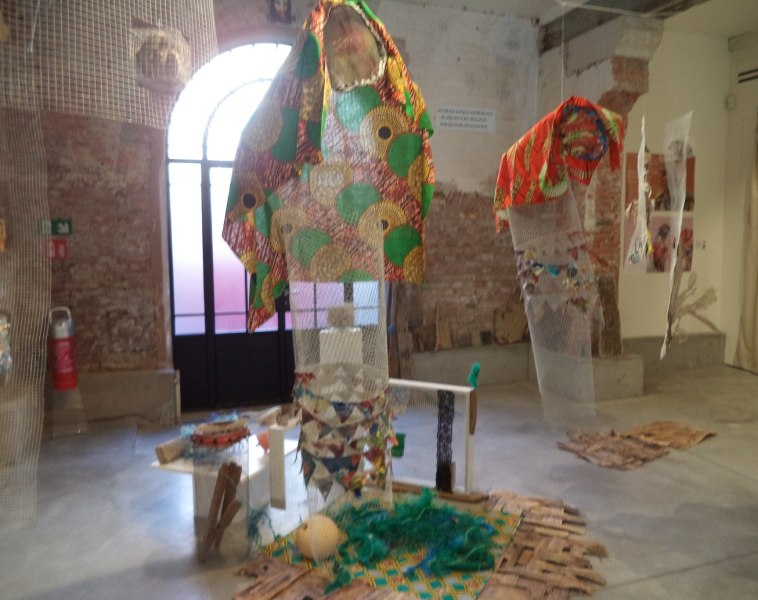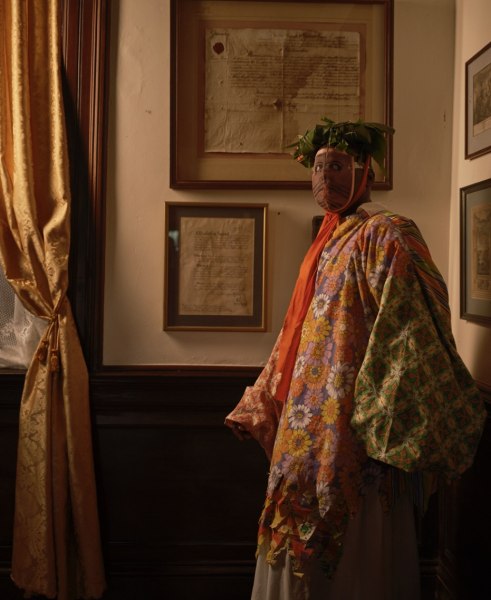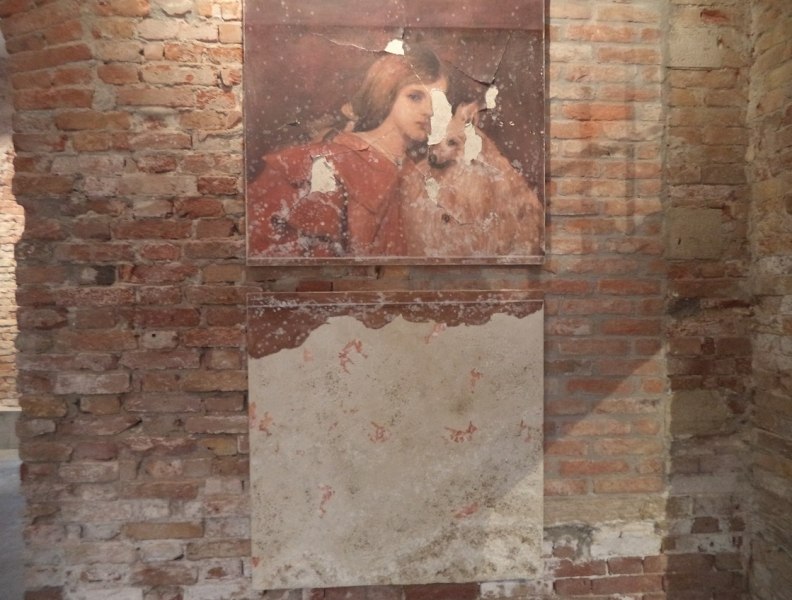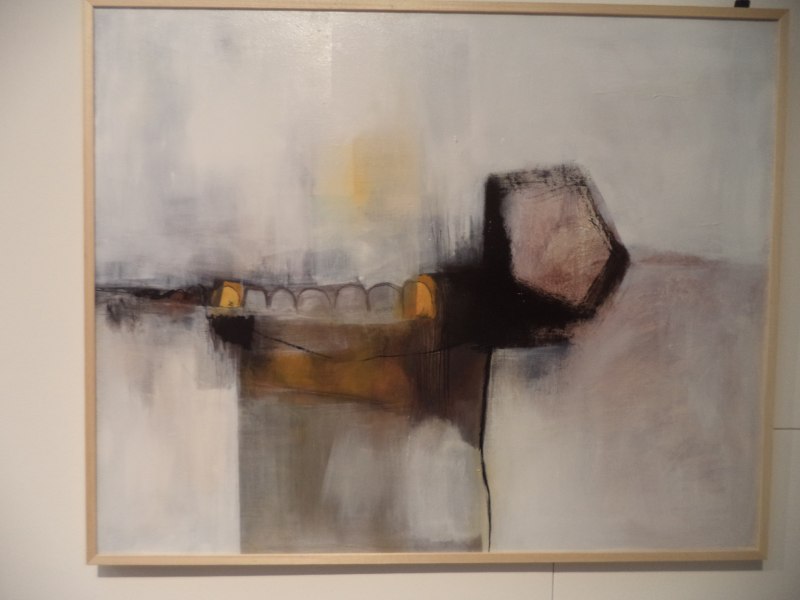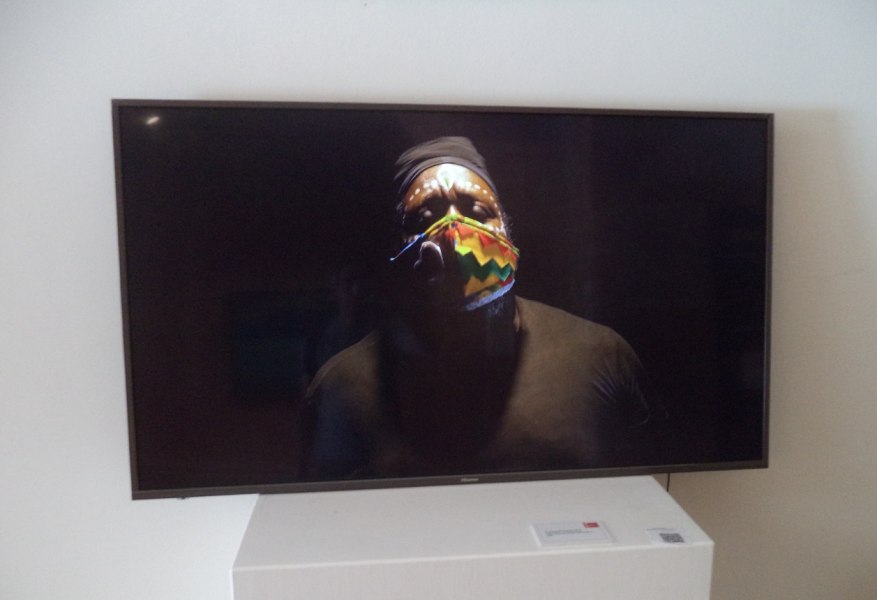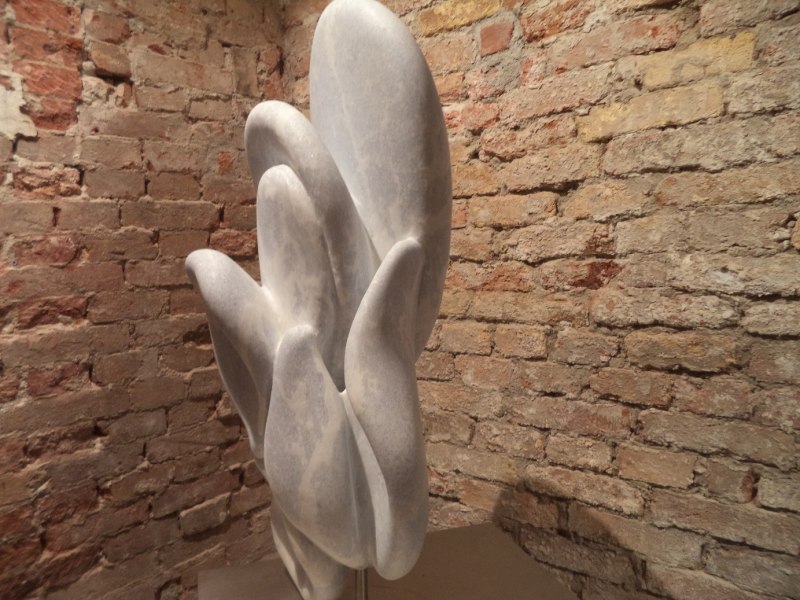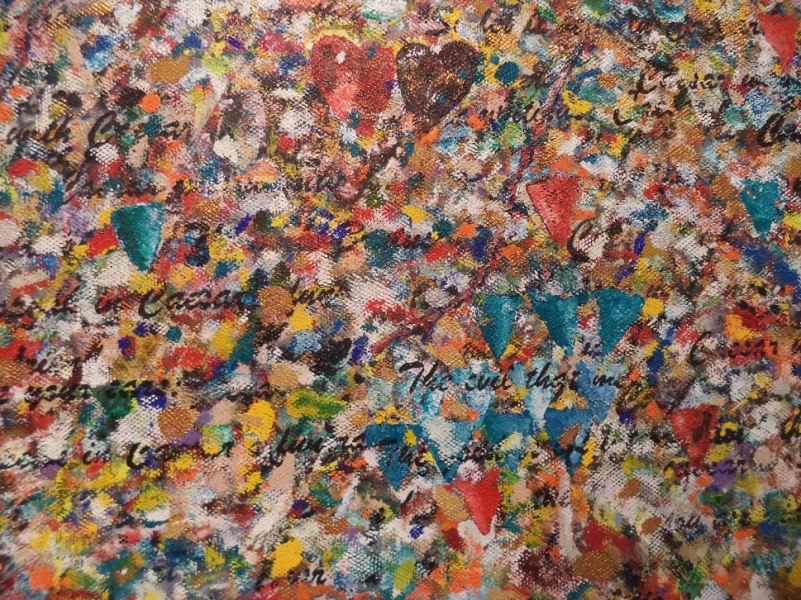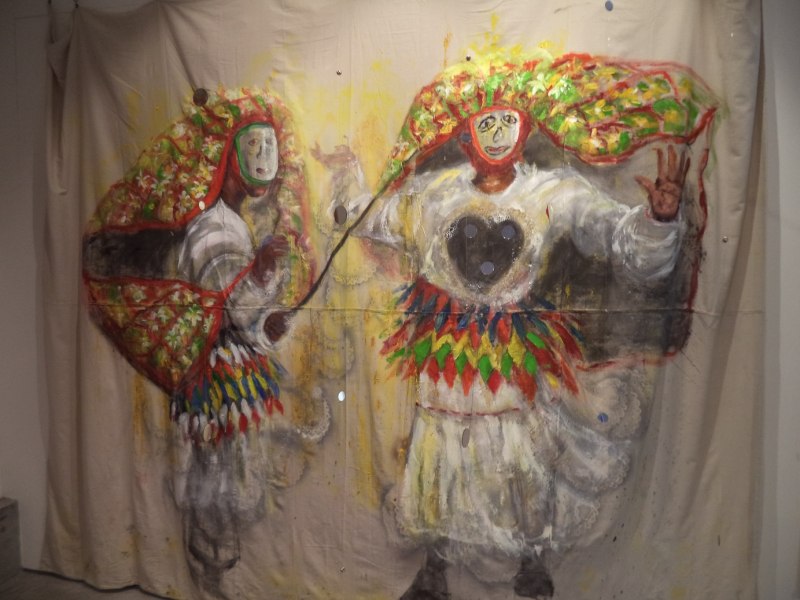Alla Biennale di Venezia 2022, è possibile visitare il Padiglione Nazionale di Grenada, in cui espone il Cypher Art Collective (Oliver Benoit, Billy Gerard Frank, Ian Friday, Asher Mains, Susan Mains, Angus Martin, Samuel Ogilvie). Fondamentalmente, a loro interessa la reinterpretazione antropologica per un carnevale all’isola di Carriacou, lo Shakespeare Mas. Qualcosa che ha sempre recepito influenze intercontinentali (sia dall’Europa sia dall’Africa). La mostra contiene filmati, dipinti ed installazioni. Gli artisti grenadini sono stati ispirati dal letterato Edouard Glissant, per il quale le radici antropologiche non “sprofondano” mai in un “buio atavico delle culture”, così da fomentare il nazionalismo. Piuttosto, quelle “s’allargano” in superficie come il correlato dei rami, “all’opacità affettiva” per i raggi del sole che si sostengono mediante gli Altri, se le foglie materializzano una spiritualità del cielo. Precisamente, sarà impossibile la pretesa di conoscere tutto. Ci conviene l’opacità per cui < in fondo null’altro importa, se basta amare! >. Naturalmente questo aiuterà ad edificare una società multietnica. Nella sua miniatura, sarà artisticamente un viaggio di scoperta, grazie alla fervida immaginazione che vorrà affezionarsi ai riferimenti antropologici d’una cultura. La mostra grenadina s’intitola An unknown that does not terrify, sotto la curatela di Daniele Radini Tedeschi. Essa è ospitata al Giardino Bianco Art Space. Per iniziativa della sua direttrice, Marialuisa Tadei, lei stessa espone (ma assieme ad altri italiani, fra cui si segnalano Cristina Corvino ed Elia Inderle).
Pare che lo Shakespeare Mas fosse nato all’epoca dello schiavismo per le piantagioni. Al Mercoledì delle Ceneri si lasciava eccezionalmente una libertà generalizzata di parola, ma impedendo il riconoscimento delle persone (senza la “spinta” alle vendette). Da un’altra versione, i proprietari bianchi ordinavano di recitare per il diletto privato, passando alle punizioni corporali in caso d’errore. Certamente si rivisita molto la tragedia di Shakespeare dal titolo Giulio Cesare, forse per via d’un manuale scolastico in uso nell’Impero Britannico. Il rito del combattimento coi bastoni non solo servirebbe a scandire il tempo della recitazione (secondo la tradizione africana), ma pure ad accusare simbolicamente le punizioni corporali che venivano imposte dai colonizzatori. Più in generale, lo Shakespeare Mas si discosta dal racconto delle vicende che ha un dato protagonista, come Giulio Cesare. Esteticamente, ai grenadini interessa l’incantesimo del ritmo. C’è una sorta di teatralità “atavica”, in quanto la ritualità avrebbe avuto un “destino”, e purtroppo avverso (a causa del colonialismo). Ciascun colore caldamente sgargiante dei Caraibi si percepirà opacizzato, nella sua catarsi verso la solidarietà degli uomini bianchi. Il binomio del tipo isola + turismo è fin troppo “abbracciante”, se dietro si nasconde una storia d’emarginazione.
A Venezia, l’artista Billy Gerard Frank introduce alla vera storia di Quobna Ottobah Cugoano, un attivista africano di nascita. Egli nel Settecento fu deportato come schiavo a Grenada, ottenendo la liberazione in Inghilterra, dopo una seconda vendita. Alla fine Quobna Ottobah Cugoano riuscì a frequentare i salotti intellettuali, promuovendo la causa dell’abolizionismo. Il progetto artistico di Billy Gerard Frank s’intitola Palimpsest: tales spun from sea and memories, trattando la scultura, la fotografia ed il film. L’allestimento finale consente di perdere la linearità biografica. Un attivista come Quobna Ottobah Cugoano deve continuamente chiedersi perché il destino gli abbia riservato una vita più fortunata, rispetto a milioni d’altri africani. Così egli passa dai pericolosi viaggi nell’oceano alle rilassanti memorie da salotto. Forse la risposta al < non dimenticare mai da dove sei nato > diventa un rito per il racconto di formazione. Quobna Ottobah Cugoano appare travestito, a rimarcare una personalità duplice: da schiavizzato ma orgoglioso della sua cultura, a liberatore progressista fra le tante culture. Razionalmente, un occidentale potrebbe valutare come insane alcune pratiche d’un rito vudù, per esempio. Quobna Ottobah Cugoano, una volta liberato in Inghilterra, fu battezzato dalla chiesa cristiana. Un filmato di Billy Gerard Frank gioca molto sulla dialettica fra la religione di stato e quella solo animistica. La maschera scolpita ha un collage che si percepisce “all’inconscio” d’una magia. L’effervescenza dei brillantini darebbe una “memoria corallina” alla spettralità dei sensi (espressi dalla vista e dal gusto). L’ordine violentemente imposto dello schiavismo cozza contro il ritiro pacificante nell’isola esotica, che al massimo solletica.
A Venezia, Ian Friday e Sam Ogilvie espongono la videoinstallazione dal titolo A syncretism in Kayryouacou. Lo “spirito” dello Shakespeare Mas è trasferito in un coro digitalizzato. Ma il sincretismo simbolicamente si radica nell’antropologia, a partire dall’antica creolizzazione. Possiamo inseguire la sinestesia fra le “gocce” del suono e le mani “afferranti”. Agli artisti interessa che s’indossi la mascherina, citando l’attuale pandemia. Questa ci ha costretto all’isolamento del corpo, ma anche ad una maggiore sensibilità verso lo “scandirsi” del tempo vitale. Chissà se la recitazione dei grenadini tenterà un rito propiziatorio. S’incanterebbe il laccio della mascherina, con le dita, per togliersela spiritualmente. Chi vive nell’isola percepisce di non poter evitare di metterci sempre la faccia. Al respiro affannoso della falesia, si contrappone la goccia della spiaggia accogliente. Ovviamente agli schiavizzati non era mai concessa la libertà di parola, tranne (sembra) per un giorno del Carnevale.
A Venezia, l’artista Oliver Benoit ha esposto il quadro ad acrilico su tela che si chiama Whipping the mind. Esteticamente, percepiamo che la maschera sgargiante del Carnevale sia stata mandata “al macero”. Nella ritualità grenadina, immaginiamo che funzioni la “frusta” del ballo, per neutralizzare la punizione corporale fatta dai coloni schiavisti. In accordo con l’espressionismo astratto, accade che la passionalità “infiamma” l’opacità della mente. Forse l’unica figura in grado di resistere “al macero” diventa quella del cuore. La riva con le parole in corsivo è “travolta” da sinapsi liriche, avendo una sabbiosità che traspare, dall’onirismo delle conchiglie colorate mediante il desiderio. La figura del cuore conferirebbe un ballo a quella “macchinosa” del cono, per un freddo tornado.
A Venezia, l’artista Asher Mains espone l’installazione che si chiama Empathy of space. Esteticamente, egli prova a rimarcare quanto gli oggetti da noi usati letteralmente “svuotino” un “microcosmo” della nostra personalità. Vale pure la consapevolezza che non si può mai vivere senza l’interconnessione con gli Altri. Se usiamo un oggetto, lo facciamo perché vogliamo raggiungere la “pienezza” che fuori già esiste. Asher Mains allestisce un corredo, ed in specie fra gli elementi necessari per vivere del vestito e del mobilio. Nell’insieme, è chiaro che ci si protegge. Quando entriamo nella stanza privata di chi non conosciamo, subito indaghiamo percettivamente i suoi oggetti. Nel caso dello Shakespeare Mas, per il turista occidentale s’aggiunge una forza. Il ballo del nativo deve diventare catartico, esteticamente, ed anche prima che ne impariamo la storia, antropologicamente. Allora Asher Mains cerca di rappresentare un’empatia dell’opacità. A lui interessa la decostruzione, tramite l’intuizione lirica. Chi si traveste, comunque travisa. L’abbigliamento dovrà “svuotarsi” in funzione dell’abbinamento. Conterà il muro portante, non la facciata decorativa. Paradossalmente, più si giustappongono i vestiti, più c’incuriosisce la griglia delle loro selezioni. Magari scopriremo che una rete da pesca è stata riciclata appositamente per il Carnevale. Si narra che Edouard Glissant s’ispirasse ascoltando il rumore del mare. Ma resta una causalità completamente surrealistica. Asher Mains insiste molto sul dettaglio del tubo forato, che non riuscirebbe ad “aspirare” le corde, i festoni e le zattere. E’ la miniatura per la “conduzione” d’una comprensione che “balla” sulla propria estasi, liricamente.
A Venezia, Susan Mains ha esposto due dipinti in tecnica mista. Per quelli, il titolo prescelto è Shakespeare Mas Player + Shakespeare Mas Synthesis. Esteticamente, l’artista dichiara un interesse a visualizzare l’intangibile. Qualcosa che riguardi una frusta che taglia l’aria, il tintinnio fra le campane, gli specchi che più si spezzano e meglio lampeggiano, i riti che sintetizzano culture lontane geograficamente… Un figurante dev’essere bravo ad immedesimarsi. Sembra che la spada faccia scintillare il “festone” d’un nemes, e sino allo stridore. Citando Georg Hegel, socialmente vi funzionerà la dialettica del signore-servo. Ma quanto l’immedesimazione del singolo travestito favorirebbe l’insorgenza, da una coscienza di classe? L’artista visualizza l’opacità della tela intatta, attorno alle figure. O forse si celerebbe una metafora per la tolleranza, nella società modernamente multiculturale. Ognuno ridipingerà liberamente il giallo del sole ed il turchese delle acque, a Grenada.
Marialuisa Tadei da sempre cerca di scolpire un “portale” dall’immanenza alla trascendenza. Soprattutto, la sua soluzione è religiosa, chiamando in causa l’armonia d’una Luce Divina. Nella dimensione del sacro, l’arte aiuta la materia ad “invocare” l’iconicità. La linea dell’orizzonte s’aprirebbe come un “orecchio”. L’udito è il senso più diretto, per la sua trascendentalizzazione, non necessitando d’un “filtro” corporeo. Dunque dal portale in Terra si passa all’orecchio in Cielo. Nel mezzo c’è la “luce” dell’icona, anziché lo “schermo” dell’idea. A Marialuisa Tadei interessa lo spiritualismo, mentre il razionalismo sembra “contorto”. La luce prospettica rimane al “miraggio” della nicchia. Le forme scolpite si percepiscono a “raggrumarsi”. Immaginiamo di poter citare le vertebre del corpo umano, che permettono d’irradiare una forza. E’ la funzione dell’icona religiosa, dove il semplice simbolo dovrà supportare persino una trasfigurazione. La luce prospettica s’opacizzerà in quanto “rannicchiata”. Ma nel contempo aumenta la forza dell’ascolto, portando l’orizzonte terrestre alla trasparenza. Il tono dell’alga scolpita si percepisce più atmosferico che acquatico.
Cristina Corvino ha una formazione da restauratrice. Lei sa che nelle dimore storiche sovente si trovano muri con affreschi irrecuperabili, per incuria. Nasce così la serie artistica che si chiama Distacchi. Il vecchio muro riceverà “magicamente” un nuovo dipinto, anche se “correttamente” la dialettica rimarrà. E’ noto il problema di quanto un restauro possa attenersi al livello del conservativo, rinunciando a superarlo. Cristina Corvino lascia gli “strappi”, perché lo spettatore le dica < peccato… >. La vita è opaca, logorandosi dalla nascita alla morte. Ciò non toglie che bisogna averne cura. Contro la figurazione, percepiamo che lo “strappo” si faccia “grattare”. E’ facile trastullarsi; ma il lasciarsi andare ci mette meno tempo a colpire! La cura richiede la costanza d’un impegno, e soffrendo comunque. Per l’esibizione di Venezia, Cristina Corvino ha portato il dittico che s’intitola Luna crescente in Capricorno. Compare la figura umana, giacché all’artista interessa citare il “distacco” degli organi interni, a causa delle malattie. Qualcuno le spiegherà accusando un destino avverso. Il dettaglio dello “strappo” avrebbe la stessa forma d’una fase lunare. Antropologicamente, l’animismo attesta che è facile sentirsi influenzati dal mondo esteriore.
Elia Inderle espone il quadro ad olio e smalto che s’intitola Limiti di pensiero n°15. Esteticamente, gli preme che la contingenza del realismo sia “epurata”. Così si permetterà all’immaginazione di rompere i limiti su cui si basa il concettualismo. Percepiamo una dialettica fra la “cerniera” della figurazione che ostruisce l’astrazione ed il “ponte” dell’astrazione che supera la figurazione. Per l’epurazione del realismo, forse immagineremo un “ferro da stiro” contro un “incudine”. Al centro l’espressionismo è poco scintillante, spento da un vapore acqueo che “culla” dall’esterno. Nella preferenza estetica per l’immaginazione, da parte di Elia Inderle, quella ricorrerebbe alla trasparenza per trasfigurare i limiti della stessa astrazione, dovuti al simbolismo. O forse si valorizzerà l’esistenzialismo, ma come un “calmo pompiere” per l’idealismo. L’immaginazione rompe le “catene” del realismo ed allena alla condivisione del pensiero (che procederà a tentoni). Se al centro vi fosse la riflessione sullo specchio d’acqua, allora noi la “allargheremmo” quantomeno ad un simbolismo: quello per cui tutti noi viviamo sulla stessa “barca”. Si percepirà l’intero quadro con l’esistenzialismo ad “epurarsi” in favore del comunitarismo.
AN AFFECTIVE OPACITY FOR THE “CARNIVALESQUE” SUN
At the Venice Biennale 2022, we can visit the National Pavilion of Grenada, where the Cypher Art Collective (Oliver Benoit, Billy Gerard Frank, Ian Friday, Asher Mains, Susan Mains, Angus Martin, Samuel Ogilvie) exhibits. Fundamentally, they are interested in an anthropological reinterpretation of a Carnival in the Carriacou island, the Shakespeare Mas. Something that always adopted the intercontinental influences (both from Europe and from Africa). The exhibition contains video, paintings and installations. The Grenadian artists were inspired by the literatus Edouard Glissant, for whom the anthropological roots never “sink” in an “atavistic dark of the cultures”, so fomenting the nationalism. Rather, those “broaden” in the surface like their related branches, “at an affective opacity” for the sunbeams which support themselves through the Others, if the leaves materialize a spirituality of the sky. Precisely, claiming to know everything will be impossible. We better have the opacity for which < after all nothing else matters, if you just love! >. This situation of course will favour the edification of a multiethnic society. In its miniature, we will find a voyage of discovery, through a fervid imagination which will want to grow fond of the anthropological landmarks of a culture. The Grenadian exhibition is called An unknown that does not terrify, under the curatorship of Daniele Radini Tedeschi. It is hosted at the Giardino Bianco Art Space. On the initiative of its manager, Marialuisa Tadei, she is herself an exhibitor (but together other artists from Italy, including Cristina Corvino and Elia Inderle, recommended by us).
It seems that the Shakespeare Mas was born at the time of the slavery for the plantations. On the Ash Wednesday exceptionally all the people had the freedom to speak, but with the prohibition of identification for everyone (without the “incentive” to avenge). According to another version, the white men owners ordered to recite for the private pleasure, passing to the corporal punishments in case of mistake. Surely the tragedy of Shakespeare called Julius Caesar is very reexamined, perhaps due to a school textbook used in the Britannic Empire. The ritual of the fighting sticks not only would serve to beat time for the acting (according to the African tradition), but also to accuse symbolically the corporal punishments that were ordered by the colonizers. More generally, the Shakespeare Mas distances itself from the tale of the events lived by a certain protagonist, as Julius Caesar. Aesthetically, the Grenadians are interested in the enchantment of the rhythm. There is a sort of “atavistic” theatricality, because the ritual would have had a “destiny”, and unfortunately adverse (due to the colonialism). Every colour warmly garish of the Caribbean will be perceived opacified, in its catharsis into the solidarity of the white men. A binomial of the type island + tourism is all too “embracing”, if behind a story of marginalization is hidden.
In Venice, the artist Billy Gerard Frank introduces the real history of Quobna Ottobah Cugoano, an activist, African by birth. In the Eighteenth Century, he was deported as a slave to Grenada, obtaining the liberation in England, after he was sold a second time. Finally Quobna Ottobah Cugoano was able to frequent the intellectual salons, promoting the cause of the abolitionism. The artistic project of Billy Gerard Frank is called Palimpsest: tales spun from sea and memories, concerning the sculpture, the photography and the movie. The final set-up allows the loss of a biographic linearity. An activist as Quobna Ottobah Cugoano continually needs to ask himself why the destiny reserved for him a luckier life, compared to millions of other African people. So he passes from the dangerous trips in the ocean to the relaxing memoirs from a salon. Maybe the answer for the < never forget where you were born > becomes a ritual for a coming-of-age novel. Quodna Ottobah Cugoano appears disguised, underlining a dual personality: from the enslaved state, but proud of his culture, to the progressive state of a liberator, between the many cultures. Rationally, a Westerner could evaluate some ritual practices as insane, for example from the voodoo. Quobna Ottobah Cugoano, after his liberation in England, was baptized by the Christian church. A movie of Billy Gerard Frank plays much on the dialectics between the state religion and the mere animism. The sculpted mask has a collage that we perceive “at the unconscious” of a magic. The effervescence of the glitters would give a “coralline memory” to the spectrality of the senses (expressed by the sight and the taste). The order violently imposed of the slavery clashes with the pacifying retreat on the exotic island, that if anything tickles.
In Venice, Ian Friday and Sam Ogilvie exhibit the videoinstallation called A syncretism in Kayryouacou. The “spirit” of the Shakespeare Mas is transferred in a digitalized chorus. However the syncretism symbolically takes root in the anthropology, starting from the antique creolization. We can imagine a synaesthesia between the “drops” of the sound and the “grasping” hands. The artists are interested in people who wear the face mask, mentioning the current pandemic. This one forced us to an isolation of the body, but also to a greater sensitivity in “beating” a vital time. Who knows if the acting of the Grenadians will attempt a propitiatory ritual. The lace of the face mask would be enchanted, with the fingers, to remove it spiritually. Somebody who lives on the island perceives that he can not avoid putting always “his face”. The drop of a welcoming beach contrasts with the labored breathing of a cliff. Of course the enslaved people were not allowed to speak freely, except (it seems) for one day in the Carnival.
In Venice, the artist Oliver Benoit exhibited a picture in acrylic on canvas that is called Whipping the mind. Aesthetically, we perceive that the garish mask of the Carnival went “to the shredder”. In the Grenadian ritual, we imagine that the “whip” of the dance functions, to neutralize the corporal punishment, done by the pro-slavery colonists. In accordance with the abstract expressionism, it happens that the passionateness “inflames” the opacity of the mind. Perhaps the only figure able to withstand “the shredding” is about the case of a heart. The shore with the words in cursive is “overwhelmed” by the lyric synapses, having a sandiness which shines through, from the oneirism of the shells, coloured by means of the desire. The figure of the heart would confer a dance to the “cumbersome” figure of the cone, for a cold tornado.
In Venice, the artist Asher Mains exhibits the videoinstallation called Empathy of space. Aesthetically, he tries to underline how much the objects used by us literally “empty” a “microcosm” of our personality. Also is valid the awareness about our impossibility to live without an interconnection with the Others. If we use an object, so we do this because we want to reach “a fullness” that outside already exists. Asher Mains sets up a trousseau, and especially between the elements, that are necessary to live, of the clothes and of the furniture. Overall, it is clear that we protect ourselves. When we enter into the private room of somebody unknown by us, immediately we investigate perceptually his objects. In the case of Shakespeare Mas, for the western tourist a strength is added. The dance of the native has to become cathartic, aesthetically, and also before that we learn its history, anthropologically. So Asher Mains tries to represent an empathy of the opacity. He is interested in the deconstruction, through the lyric intuition. Somebody who disguises himself, however misrepresents. The clothing will have to “empty itself” as a function of a matching. The load-bearing wall will count, and not a decorative facade. Paradoxically, the more the clothes are juxtaposed, the more we are intrigued by a grill of their selection. Perhaps we will discover that a fishnet was recycled expressly for the Carnival. It is said that Edouard Glissant was inspired listening to the sound of the sea. However there is a causality completely surrealistic. Asher Mains strongly insists on the detail of a perforated pipe, which would not be able to “suck” the ropes, the garlands and the rafts. This is a miniature for the “conduction” of a comprehension which “dances” on the own ecstasy, lyrically.
In Venice, Susan Mains exhibited two paintings in mixed media. For those, the selected title is Shakespeare Mas Player + Shakespeare Mas Synthesis. Aesthetically, the artist declares that she is interested in visualizing the intangibility. Something that concerns a whip which cuts the air, the jingling of the bells, the mirrors that the more are broken the better are flashing, the rituals which synthetize some cultures geographically distant… A walker-on has to be good at identifying. It seems that a sword allows the “garland” of a nemes to sparkle, and until its screeching. Mentioning Hegel, socially there the master-slave dialectic will function. But how much would the identification of the single disguised man favour an insurgence, from a class consciousness? The artist visualizes the opacity of an intact canvas, around the figures. Or rather a metaphor for the toleration, in modern way for the multicultural society, would be hidden. Everyone freely will repaint the yellow of the sun and the turquoise of the waters, in Grenada.
Marialuisa Tadei always tries to sculpt a “portal” from the immanence to the transcendence. Principally, her solution is religious, calling into question the harmony of a Divine Light. In the dimension of the sacredness, the art helps the matter to “invoke” the iconicity. The horizon line would be opened like an “ear”. The hearing is the most direct sense, for its transcendentalization, because it does not require a corporeal “filter”. So from the portal on Earth we pass to the ear in Heaven. In the middle there is the light of an icon, instead of the “screen” of an idea. Marialuisa Tadei is interested in the spiritualism, while the rationalism seems “contorted”. The opening of the perspective remains at the “mirage” of a recess. The sculpted shapes are perceived “clotting” each other. We imagine that we can mention the vertebrae of the human body, which allow irradiating a strength. This is the function of the religious icon, where the simple symbol will have to support even a transfiguration. The opening of the perspective will opacify itself because it is curled up. But at the same time the strength of the listening increases, bringing the terrestrial horizon to a transparency. The tone of the sculpted seaweed is perceived more atmospheric than aquatic.
Cristina Corvino has a background in restoration. She knows that in the historical dwellings often we find walls with the irrecoverable frescoes, due to the negligence. So the artistic series called Distacchi was born. The old wall will receive “magically” a new painting, although the dialetics will remain, “correctly”. We know the problem about how much a restoration can abide by the level of the conservative, giving up on its overcoming. Cristina Corvino leaves the “tears”, in order that the viewer says to her < what a pity… >. The life is opaque, wearing out from the birth to the death. This does not mean that we have to take care of it. Against the figuration, we perceive that the “tear” allows to “be scratched”. It is easy to mess around with themselves: but the self-neglect takes less time to hit us! The care requests the perseverance of a diligence, and however suffering. For the exhibition in Venice, Cristina Corvino brought the diptych called Luna crescente in Capricorno. The human figure appears, because the artist is interested in mentioning the “detachment” of the internal organs, due to the diseases. Somebody will explain those accusing an adverse destiny. The detail of the “tear” would have the same shape of a moon phase. Anthropologically, the animism attests that easily we feel influenced by the external world.
Elia Inderle exhibits the picture in oil and enamel that is called Limiti di pensiero n°15. Aesthetically, he wishes that the contingency of the realism is “purged”. So the imagination will be allowed to break the limits on which the conceptualism is based. We perceive the dialectics between a “zipper” of the figuration that obstructs the abstraction and a “bridge” of the abstraction that overcomes the figuration. For a purification of the realism, perhaps we will imagine a “steam iron” against an “anvil”. In the middle the expressionism is scarcely sparkling, turned off by a water vapour which “cradles” from the outside. In the aesthetic preference for the imagination, from Elia Inderle, this one would resort to the transparency to transfigure the limits even of the abstraction, due to a symbolism. Or rather the existentialism will be valorized, although as a “calm fireman” for the idealism. The imagination breaks the “chains” of the realism and trains to a sharing of the thought (which will grope). If in the middle there was a reflection on the body of water, so we would “broaden” it at least into a symbolism: precisely, this one remembers us that we are all living in the same “boat”. We will perceive the entire picture with the existentialism in its “purification” in favour of the communitarianism.

